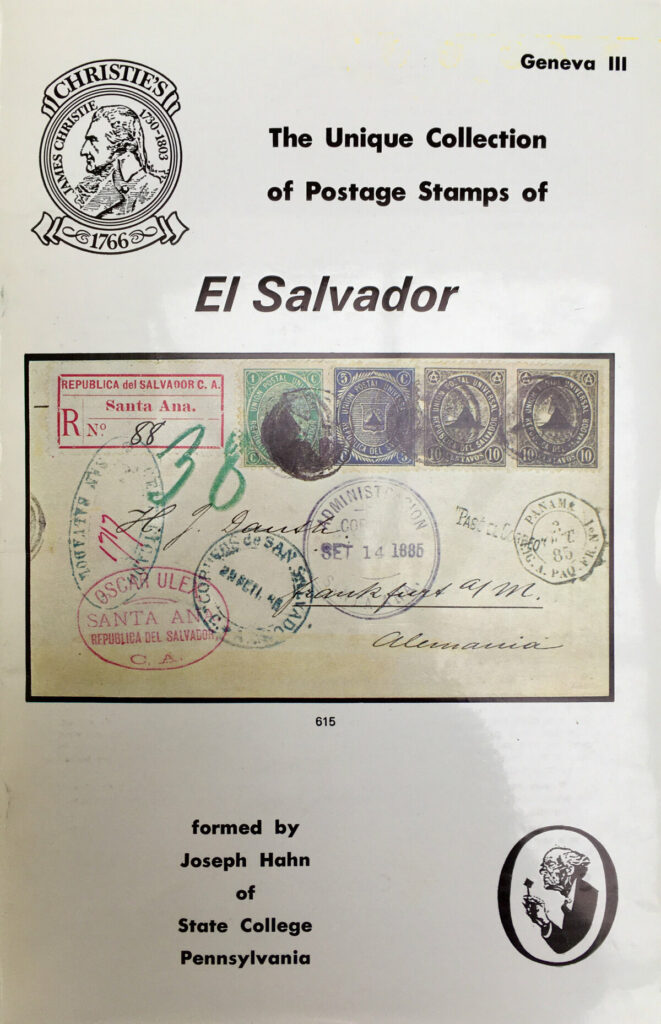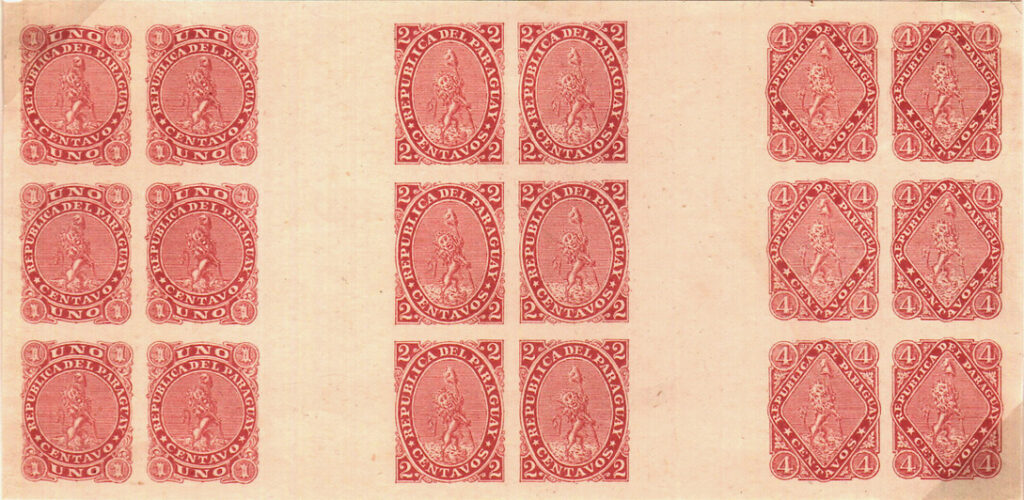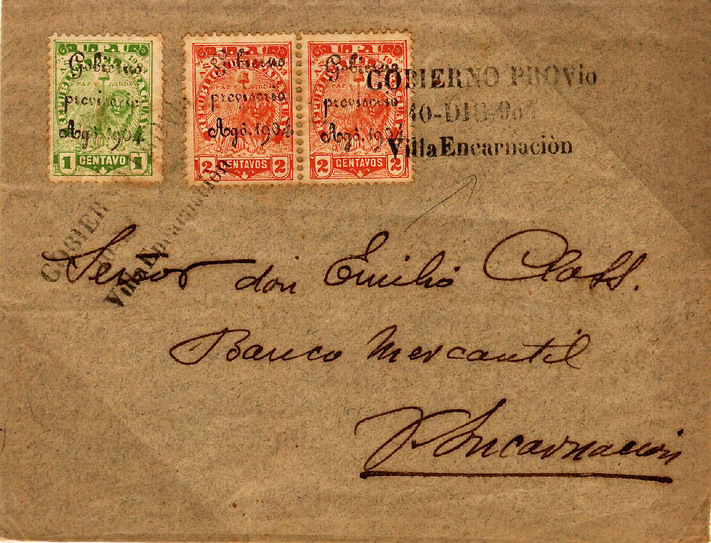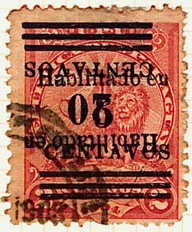
Joe Hahn has been a well known figure in Latin American philately for many years, both as a collector and author. In this article, Joe discusses two of the formidable collections he has formed; those of El Salvador and Paraguay.
Images selected for this article were originally in the Hahn Paraguay Collection
CLA When and how did you start collecting stamps?
JH I started collecting stamps when I was about 8 years old. I used to like going through my father’s desk. He had a small drawer where he would put different stamps that appealed to him that were not the then current 3c stamp of Washington (from 1939 Presidential series.)
CLA You have built world class collections of El Salvador and Paraguay in the past. Fascinating countries to collect but something of a philatelic backwater for more mainstream collectors. What were the reasons for choosing these two countries?
JH Before collecting El Salvador, I collected the U. S. issues of 1861 to 1866. After acquiring three albums of material I ran into a wall as the material was hard to find and expensive.
I started looking for a secondary collecting interest and chose El Salvador as my then philatelic mentor had been collecting Nicaragua for over thirty years.
I wanted a country with 19th and early 20th century material that was unpopular and inexpensive. It also had to be not well researched so that I could undertake original studies and that had a fair amount of material (stamps, proofs, essays, covers) available.
CLA Your collection of El Salvador was auctioned by Christie’s many years ago. Did you break completely with collecting El Salvador or did you maintain any favoured ‘sidelines’?
JH I broke for a while from collecting El Salvador. Instead I collected the cancellations of the Gold Coast, the Escuelas of Venezuela, the Departmental issues of Argentina, the issues of the General Gouvernement of Poland (WWI & WWII) and a few other areas.
I did return to El Salvador after a few years and did a study on the lithographic issues of 1899 and 1900.
CLA Do you recall any El Salvador items that you were particularly fond of?

JH Yes, I especially liked the cover shown on the front cover of my auction catalogue (above); also the only known cover with the One Peso of 1891. I was also fond of the sheet of fifty and block of forty-five of the Transito Territorial overprint issue and the strip of three of the 100 centavos of the 1897 issue on cover.
CLA Your Paraguay collection is recognised as one of the finest and most comprehensive ever assembled. What were the key challenges of forming such a collection?
JH The largest challenge was finding good information about the stamps. The Kneitschel 1947 catalog and Hugo Griebert’s ‘Philatelic Notes and Offers’ were two of the primary sources of good information.
CLA What items in your Paraguay collection gave you the most pleasure to acquire?
JH The full front advertising covers of the 1879 issue, the full sheets of the overprints on the Peso stamps of 1907 – 1910 and the many essays of the 1860 bogus issue as well as the envelopes of this issue.
CLA Readers may know that you have written a detailed Handbook on the stamps of Paraguay. What prompted you to write the Handbook?
JH I discovered a wealth of information on the issues of Paraguay because I examined many, many philatelic magazines in the APRL and wanted to share this with other collectors.

CLA How does the Handbook differ in content and approach from the 1947 Kneitschel catalogue?
JH There are some items listed in the Kneitschel catalog of which I question the authenticity.
The handbook endeavours to list the quantities issued (if known), the varieties, the largest multiples, unusual covers, the number of known covers for the very early issues plus the sources of information on issues.
One of the outputs of building a large holding of a particular country is that you start to get a feel for the relative abundance or scarcity of particular issues or values…and whether the catalogs have them priced accurately or otherwise…
CLA How well do you think Scott does with Paraguay and El Salvador, in this regard?
JH In most cases I think they do a pretty good job. I and other collectors have been providing information to Scott and they have been updating information and prices in most of the cases I am aware of.
One problem is that, as Paraguay is not in the forefront of collector’s interests, you can have scarce or rare stamps with a very low retail price. Remember, demand can be greater than supply or it can be the other way around.

CLA How much more is there to discover in the philately of El Salvador and Paraguay? What areas of study could reward closer attention?
JH Guillermo Gallegos and I have authored a handbook on El Salvador.
Part 1 was published in 2015 and covers the postal history of the country from 1525 to 1866. This volume of 297 pages was published by the Collector’s Club of Chicago and can be obtained from them.
The second volume, covering the period of the issue of the first stamp in 1867 to early 1900, has just been published by the Royal Philatelic Society of London. It is 870 pages long with over 2800 illustrations (this will be the subject of a future article – Ed.).
It is exhaustive but there are still a fair number of details to be discovered. New and improved information is always worth pursuing.
CLA How much of an issue are forgeries for the Paraguay and El Salvador collector?
JH I would say a fair amount, with Paraguay taking the lead. For example in Paraguay almost every air mail stamp has been counterfeited, as have many of the early issues.
In El Salvador, the Seebeck reprints are the biggest problem. There is a lot of information about these in the second volume of the handbook.
Additionally, the 1874 ‘contra sello’ overprints, the 1899 overprints, the ‘wheel’ overprints and the 1900 surcharges are all problem areas.

CLA In the 1980’s, you edited The Seebecker, a journal dedicated to the study of the work of Nicholas Seebeck. Do you feel that most of the questions relating to Seebeck have now been asked and answered? Or are there still ‘uncharted’ areas of his output that future philatelists could be working on?
JH I would say most definitely.
When I worked with Simine Short on a study of the reprints using a spectrograph, it became apparent to me that with the use of this equipment it may be possible to date the various reprintings. If there is a collector with access to a spectrograph this could be an interesting and rewarding area of study.
There are also other areas, such as a detailed study of the perforations on the Seebecks as a possible means of making a determination of whether a stamp is an original or a reprint (for more information on this scientific method of study see Volume 4, Number 1 of The Seebecker; copies available from the APRL).
CLA You have written extensively on Seebeck’s activities in the past. From unanimous condemnation and pariah status, he now seems to be viewed in a more favourable light with something of a resurgence of interest in his work. What is your view on the Seebeck legacy?
JH I think Seebeck was just a businessman who had a profitable idea and was partly vilified by another business man who was angry that he was not able to profit from the idea.
The biggest vilifier of Seebeck was J. Walter Scott*, who in his early days produced what we consider counterfeits today but was not condemned at the time that he made them. He was also angry at the Calman Brothers** who had purchased his business but who engaged in acts he did not approve.
I feel there is some evidence that Schernikow*** and the Calmans may have produced many of the reprints after Seebeck’s death in 1899.
*stamp dealer and leader of the North American branch of the Society for the Suppression of Speculative Stamps
** stamp wholesalers who purchased J. Walter Scott’s retail business, renaming it Scott Stamp & Coin Co.
***Seebeck’s former brother-in-law and El Salvador vice-consul in New York

CLA If you were a young man again, with decades of collecting time ahead of you, where do you think you would focus your efforts?
JH As I have done before I would focus my interest on what excited and pleased me. With that caveat, I would consider collecting fairly modern postal history, especially from unpopular, poorly known countries.
For example, postally used covers with the Katanga (Congo) handstamps. Another possibility would be foreign colonies of Paraguay including – and perhaps emphasizing – modern times.
Has anybody done a study of Japanese colonies in Paraguay? I did an article for the American Philatelist on the Foreign Colonies of Paraguay, one of whom issued its own stamps. Many countries in Latin America have similar colonies…

I hope all the work Joe has put into his formidable handbook on the stamps of Paraguay is one day published on paper with beautiful color illustrations from his collection. It is a real masterwork, like the new Salvadoran handbook, and will fire the imagination of a new generation of collectors.
Several years ago, Joe sent me several CD’s. One of the CD’s contains the WORD documents belonging to his website (https://www.oocities.org/~joehahn/paraguay.html). Another contains the 700+ scans for his collection.
I have placed them on my computer. Since a few days, I am working on a complete WORD document including bibliographic references. Yesterday (24-08-2024) I sent him a first draft of the first part (til 1902). I will also add the next chapters, but those do not have pictures for the stamps or covers. I hope to get his reaction very soon. I need to ask his permission to add pictures from his collection as well.
In my spare time I publish standard catalogues of revenue stamps, you probably already know my UK and Commonwealth catalogues, also there are some for European countries in print. Less well known is that I (ambitiously? foolishly?) sporadically work on draft listings for other countries of the world including Latin America. For Colombia, Ecuador and Spanish Antilles (Cuba, Porto Rico 19th century) drafts are reasonably well advanced. I think I have most of the usual older books by Akerman, Joe Ross and others but at the moment I have nothing on Haiti – anything you can suggest that would be useful for this small country? Once a project reaches say 90% complete, I look for help from other dealers and collectors to add information and to help provide scans for a few of the last more elusive items. Something where we might work together once in a while?
Indeed, I have a copy of your excellent Commonwealth catalogue in my library.
I don’t know of an existing publication on Haiti revenues but the Haitian Philatelic Society produced a checklist of all stamps known at the time, back in the late ’70’s. It covers the period 1883-1953.
In contrast to revenue stamps overprinted for postal use, Haiti has also done the opposite and commondeered postal stamps for fiscal purposes. Peter Jeannopoulos produced a very good listing of these, along with his exhibit.
I’ll forward details of all the above on to you.
Joe send me 6 CD’s with his information on Paraguayan stamps, but I still have not looked through all the material he send me. Still curious what to find